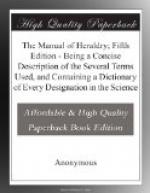THE EXTERNAL ORNAMENTS OF ESCUTCHEONS.
The ornaments that accompany or surround escutcheons were introduced to denote the birth, dignity, or office of the person to whom the coat of arms belongs. We shall merely give the names of the various objects in this place, and refer the reader to the different words in the Dictionary. Over regal escutcheons are placed the crown which pertains to the nation over which the sovereign presides. The crown is generally surmounted with a crest: as in the arms of the kings of England, the crown is surmounted by a lion statant, guardant, crowned.
Over the Papal arms is placed a tiara or triple crown, without a crest.
Above the arms of archbishops and bishops the mitre is placed instead of a crest.
Coronets are worn by all princes and peers. They vary in form according to the rank of the nobleman. A full description will be found in the Dictionary of the coronets of the prince of Wales, royal dukes, dukes, marquises, earls, viscounts, and barons.
Helmets are placed over arms, and show the rank of the person to whom the arms belong: 1st, by the metal of which they are made; 2dly, by their form; 3dly, by their position. See the word HELMET in the Dictionary.
Mantlings were the ancient coverings of helmets to preserve them and the bearers from the injuries of the weather. It is probable that they were highly ornamented with scroll-work of gold and silver, and their borders or edges cast into fanciful shapes. They are now formed into scroll-work proceeding from the sides of the helmet, and are great ornaments to an escutcheon. See a more full description under the word MANTLING.
CHAPEAUX.
A chapeau is an ancient hat or rather cap of dignity worn by dukes. They were formed of scarlet velvet and turned up with fur. They are frequently used instead of a wreath under the crests of noblemen and even gentlemen.
The wreath was formed by two large skeins of silk of different colours twisted together. This was worn at the lower part of the crest, not alone as an ornament, but to protect the head from the blow of a mace or sword. In Heraldry the wreath appears like a straight line or roll of two colours generally the same as the tinctures of the shield. The crest is usually placed upon the wreath.
The crest is the highest part among the ornaments of a coat of arms. It is called crest from the Latin word crista, which signifies comb or tuft.




